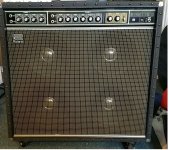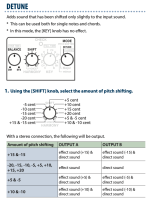which is where the newer Digital pedals can come in
currently our common Tech level is we DO have devices that can
sample, convert to digital, process, then spit back out our audio signal
faster than we can think
consider live pitch correction for vocalists from TC-Electronics, and how easily
this is done with a slew of available devices.. or consider my Roland Vocalizer
keyboard, where i lay right hand chords and sing through the input and
you hear a full vocal ensemble at the audio output in real time
if you have two pitch shifting pedals,
one tweaked for (M-)
one tweaked for (M+)
then blended with the original signal
all in line on a pedalboard within reach of your fingers
for fine volume or spread adjustments
it should be possible to simulate 3 reed meusette
while i do not personally use these for any meusette FX sims, i DO
have an octaver, a Whammy pedal, and two controllable Boss pitch shifter pedals that i
use when i run a Guitar patch from my keys.. one shifter goes ,down a half step
and one up, which gives me the ability to simulate fretboard string finger bends
in either direction with my foot as i play..
the Digitech whammy pedal sims the whammy bar of course
if you know "Jessica" from the Allman Brothers, then you know why
i put that together as soon as i realized the capability was available
and affordable.. the Octaver was added because of layla
these digital pedals are so fast you really cannot tell
it was easy for me to always play with this edge of tech
because aside from accordions and MIDIVox i also have
an AX-1 Keytar and an Axis Keytar/Synth, and have always
craved to be able to play stuff that is generally impossible for an
accordionist who never got to be a Rock God to do
on background, i can admit that the first really great and useable Synth
patch i ever crafted was on my DW-8000 and was modeled after
Wes Montgomery's sound.. the second patch i crafted was a sim
of Carlos Santana..
interestingly, that whole PILE of keyboards and gear cost less than one Digital Accordion


